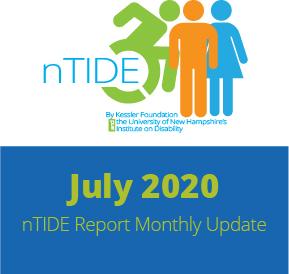Kessler Foundation and University of New Hampshire nTIDE Report–featuring the Just in Time Employment Supports Project, a multi-state project of the University of Iowa Midwest Disability Employment Consortium that implements virtual networks to support

Credit: Kessler Foundation
East Hanover, NJ – August 7, 2020 – July job numbers raise concerns about long-term employment prospects for Americans with disabilities, according to today’s National Trends in Disability Employment – Monthly Update (nTIDE), issued by Kessler Foundation and the University of New Hampshire’s Institute on Disability (UNH-IOD). Prolonged unemployment may discourage workers, causing them to stop looking for work.
nTIDE COVID Update (month-to-month comparison)
In the Bureau of Labor Statistics (BLS) Jobs Report released Friday, the employment-to-population ratio for working-age people with disabilities decreased from 28.4 percent in June 2020 to 28.1 percent in July 2020 (down 1.1 percent or 0.3 percentage points). For working-age people without disabilities, the employment-to-population ratio increased from 67.7 percent in June 2020 to 68.4 percent in July 2020 (up 1 percent or 0.7 percentage points). The employment-to-population ratio, a key indicator, reflects the percentage of people who are working relative to the total population (the number of people working divided by the number of people in the total population multiplied by 100).
“Comparing month-to-month numbers (June 2020 to July 2020), we see a leveling off of the employment-to-population ratio for people with and without disabilities, which may reflect regional resurgences of COVID-19 infections and restrictions of economic activity,” said John O’Neill, PhD, director of employment and disability research at Kessler Foundation. “This is in contrast to the last several months, where we saw month-to-month improvements,” he added.
The labor force participation rate for working-age people with disabilities decreased from 34.4 percent in June 2020 to 33.0 percent in July 2020 (down 4.1 percent or 1.4 percentage points). For working-age people without disabilities, the labor force participation rate also increased from 76.2 percent in June 2020 to 76.4 percent in July 2020 (up 0.3 percent or 0.2 percentage points). The labor force participation rate is the percentage of the population that is working, not working and on temporary layoff, or not working and actively looking for work.
“A decrease in the labor force participation rate for people with disabilities raises a red flag,” cautioned economist Andrew Houtenville, PhD, research director of the University of New Hampshire’s Institute on Disability. “It suggests that workers are losing their jobs permanently after being on furlough, and have stopped looking for work and thus, exited the labor force,” “With the potential impact of the recent surges in COVID-19 cases, we should be concerned about long-term employment stress for people with disabilities.”
nTIDE August COVID Update – Friday, August 21 at 12:00 pm Eastern
Stay tuned for more about the employment of people with disabilities as we follow the impact of COVID-19 and look at the numbers in more detail.
Traditional nTIDE Numbers (comparison to the same time last year)
The employment-to-population ratio for working-age people with disabilities decreased from 31.2 percent in July 2019 to 28.1 percent in July 2020 (down 9.9 percent or 3.1 percentage points). For working-age people without disabilities, the employment-to-population ratio also decreased from 74.9 percent in July 2019 to 68.4 percent in July 2020 (down 8.7 percent or 6.5 percentage points).
The labor force participation rate for working-age people with disabilities decreased from 34.1 percent in July 2019 to 33 percent in July 2020 (down 3.2 percent or 1.1 percentage points). For working-age people without disabilities, the labor force participation rate also decreased from 77.9 percent in July 2019 to 76.4 percent in July 2020 (down 1.9 percent or 1.5 percentage points).
For reference, July 2020, among workers ages 16-64, the 4,063,000 workers with disabilities represented 3.0 percent of the total 134,977,000 workers in the U.S.
Beyond the Numbers
The impact of the COVID-19 pandemic on the U.S. labor market is profound and ongoing. Millions of workers are affected across all sectors, with recovery hindered by resurgent outbreaks in the majority of states. Most severely affected are populations characterized by the intersections of race, poverty, and disability, and the organizations and agencies that support their transition to competitive employment and maximal independence. Technology has emerged as fundamental to the viability of businesses and nonprofit organizations, and to the ability of individuals to stay engaged in the labor force.
As the pandemic triggered lockdowns and closures, the advantages for individuals and organizations with technology-based work flows were immediately apparent, according to Elaine E. Katz, MS, CCC-SLP, senior vice president of the Center for Grants and Communications at Kessler Foundation. The majority of the Foundation’s recent COVID-19 emergency grants went to grantees with acute needs for computers, mobile technology, and internet connectivity.
Well in advance of the pandemic, the Foundation was aware of the potential for technology to improve the outcomes of disability employment initiatives. In 2017, a Kessler Foundation Signature Employment Grant funded the Just in Time Employment Supports Project, a multi-state project of the University of Iowa Midwest Disability Employment Consortium, funded through the State University of Iowa. The Consortium partnered with the University Centers for Excellence in Developmental Disabilities of Iowa, Nebraska, and South Dakota, to pilot the use of mobile technology, such as cell phones and tablets, as well apps for facilitating direct communication, to create virtual networks of support for job coaches, workers, and other stakeholders.
The two-year Just in Time Project yielded valuable information about the many ways that utilization of mobile technology in supported employment can encourage open communication, enable timely interventions, and foster greater independence for people with disabilities.
“We recognized that the integration of virtual platforms offered through Just in Time Supports was a way to improve employment outcomes. Incorporating communications technology means job coaches can maintain close contact with colleagues and clients, providing timely support that benefits workers and employers,” Katz said. “The ability to connect remotely means coaches can serve more clients, including those in rural areas, and provide more efficient services.”
The COVID-19 pandemic casts a new light on the findings of the Just in Time Support Project. “The use of technology in disability employment initiatives is no longer optional,” Katz asserted, “it’s essential.”
The Project’s structure and scale yielded another important asset ? the Consortium has established a large and functional network throughout the Midwest. ‘The ability to act collectively will be of critical importance,” Katz added, “as the stakeholders in disability employment deal with the challenges and opportunities of the COVID economy.”
###
Ask Questions about Disability and Employment
Each nTIDE release is followed by a Lunch & Learn webinar at 12:00 pm Eastern. This live broadcast, hosted via Zoom Webinar, offers attendees Q&A on the latest nTIDE findings, provides news and updates from the field, as well as invited panelists to discuss current disability-related findings and events. On AUgust 7, Wendy Parent-Johnson, PhD, director of the Sonoran University Center Excellence in Developmental Disabilities at the University of Arizona, and Julie J. Christensen, LMSW, PhD, director of Policy and advocacy at APSE, join Dr. Houtenville, Dr. O’Neill, and Denise Rozell, Policy Strategist at AUCD. Join live or watch the recordings at: ResearchonDisability.org/nTIDE.
NOTE: The statistics in the nTIDE are based on Bureau of Labor Statistics numbers but are not identical. They are customized by UNH to combine the statistics for men and women of working age (16 to 64). nTIDE is funded, in part, by grants from the National Institute on Disability, Independent Living and Rehabilitation Research (NIDILRR) (90RT5037) and Kessler Foundation.
About Kessler Foundation
Kessler Foundation, a major nonprofit organization in the field of disability, is a global leader in rehabilitation research that seeks to improve cognition, mobility, and long-term outcomes — including employment — for people with neurological disabilities caused by diseases and injuries of the brain and spinal cord. Kessler Foundation leads the nation in funding innovative programs that expand opportunities for employment for people with disabilities. For more information, visit KesslerFoundation.org.
About the Institute on Disability at the University of New Hampshire
The Institute on Disability (IOD) at the University of New Hampshire (UNH) was established in 1987 to provide a coherent university-based focus for the improvement of knowledge, policies, and practices related to the lives of persons with disabilities and their families. For information on the NIDILRR-funded Employment Policy and Measurement Rehabilitation Research and Training Center, visit ResearchonDisability.org.
For more information, or to interview an expert, contact:
Carolann Murphy, 973.324.8382, [email protected].
Media Contact
Carolann Murphy, PA
[email protected]





